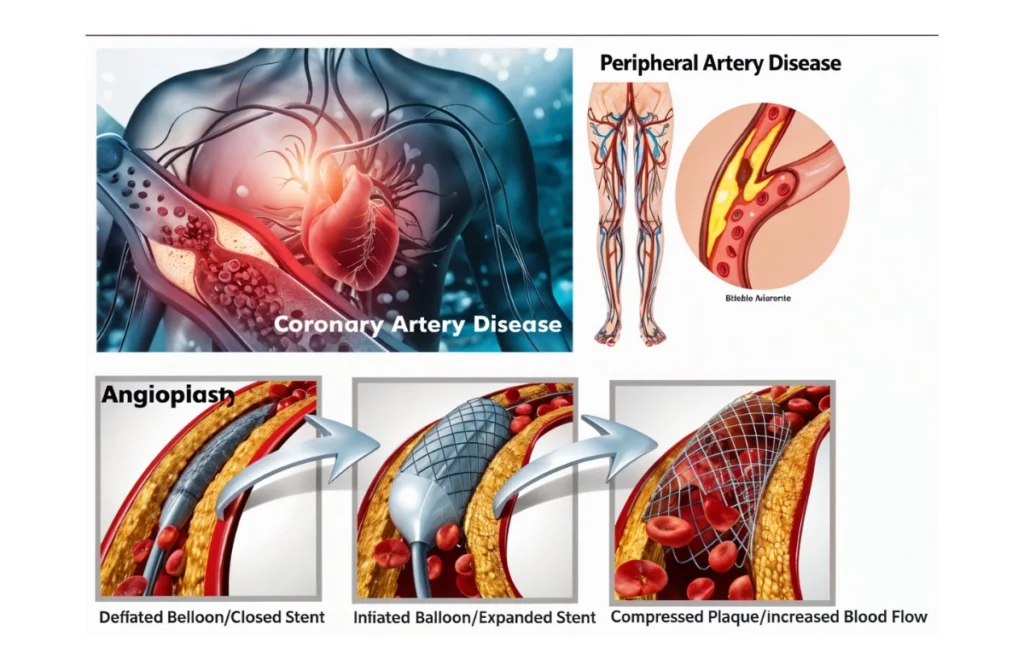Metallic Stents and Bioresorbable Scaffolds are two common types of devices used in interventional cardiology to treat obstructive coronary artery disease (CAD).
- Metallic Stents: These are stents made of metal, typically stainless steel or cobalt-chromium, which are designed to be permanently implanted in the coronary artery. The metallic stents in Chennai provide immediate mechanical support to the vessel wall but do not dissolve or disappear over time. Once in place, the metal stent acts as a scaffold to hold open the narrowed or blocked portion of the artery, allowing blood to flow freely.
- Bioresorbable Scaffolds (BRS): These are stents made of biodegradable polymers that are designed to dissolve over time, leaving behind only a minimal, non-obstructive residue. Unlike metallic stents, bioresorbable scaffolds provide temporary mechanical support to the vessel wall and then disappear. The idea behind BRS is to mimic the natural healing process of the body, allowing the treated coronary artery to return to its pre-stent state.

Diagnosis
The diagnosis of the effectiveness of bioresorbable scaffolds and metallic stents in Chennai typically involves a combination of imaging studies and clinical assessment.
- Angiography.
- Ultrasound.
- Computed Tomography (CT) scan.
In some cases, further tests such as coronary angiography or intravascular ultrasound may be needed to evaluate the performance of the device.
Treatment
The procedure for placement of metallic stents and bioresorbable scaffolds is typically performed using a minimally invasive approach called percutaneous coronary intervention (PCI). This procedure includes the following steps:
- A small incision is made in the groin or arm, and a catheter is inserted into a blood vessel and guided to the site of the blockage.
- X-ray imaging is used to guide the delivery of the stent or scaffold to the site of the blockage.
- The metallic stents in Chennai or the bioresorbable scaffolds are deployed at the site of the blockage and expanded to hold open the blood vessel. The stent or scaffold provides support to the vessel wall and helps to restore blood flow to the heart.
- The catheter will be removed after the procedure and then the incision will be closed. The patient is monitored for any complications and may be given medications to prevent blood clots and reduce the risk of restenosis.
The success of the procedure and the recovery time can vary depending on the individual patient’s health status and the extent of the blockage.
Benefits of Metallic Stents in Chennai
The benefits of using bioresorbable scaffolds and metallic stents in Chennai include:
- Improves/ restores blood flow.
- Minimally invasive.
- Quick relief of symptoms.
- Unlike metallic stents, bioresorbable scaffolds dissolve over time.
- Reduced risk of complications.
- Shorter recovery time.
Risks
It is important to note that both bioresorbable scaffolds and metallic stents in Chennai have been shown to be safe and effective for many patients, but individual results may vary.
- Restenosis
- Blood clot formation.
- Allergic reactions.
- Scaffold thrombosis.
- Incomplete resorption.
Facilities
The technology and facilities used for the placement of bioresorbable scaffolds and metallic stents in Chennai typically include the following:
- Angiography suite: A specialized room equipped with X-ray imaging equipment used to visualize the blood vessels and guide the placement of the stent or scaffold.
- Catheterization laboratory: A laboratory equipped with specialized equipment used to access the blood vessels and place the stent or scaffold.
- Stent delivery system: A specialized catheter that is used to deliver the stent or scaffold to the site of the blockage.
- Imaging equipment: Equipment such as angiography, ultrasound, or computed tomography (CT) scans that are used to visualize the blood vessels and monitor the placement of the stent or scaffold.
- Medications and consumables: Antiplatelet and anticoagulant medications, as well as other medical supplies, are needed to perform the procedure and manage potential complications.
These technologies and facilities are typically found in major medical centers, including hospitals, cardiology clinics, and specialized cath labs at a reasonable metallic stent cost. The availability and use of these technologies and facilities will vary depending on the individual patient’s specific needs and the location and severity of the blockage.
Our Doctors
Dr. M. Kathiresan will work with the patient to manage the follow-up care, including monitoring the patient’s progress, managing any potential complications, and ensuring that the stent or scaffold is functioning properly. He will also educate the patient on the benefits and risks, of metallic stent cost besides providing information on lifestyle changes and medications that may be necessary to manage the condition to ensure the success of the procedure and the overall health and well-being of the patient.
Conclusion
In conclusion, Metallic Stents in Chennai offer a reliable solution for treating blocked arteries, ensuring better blood flow and improved heart health. With advanced medical facilities and expert cardiologists, Chennai provides top-notch stent procedures for patients. Choosing the right hospital and specialist can ensure safe and effective treatment, leading to a healthier life.
Read Also, Transcatheter Mitral Valve Replacement.


